Bitcoin
From February 16 to February 24, the price of Bitcoin decreased by a little more than 2%. After BTC reached $53,000 on February 20, a slight correction began and at its lows the price reached $50,500. Now it is about $51,000.
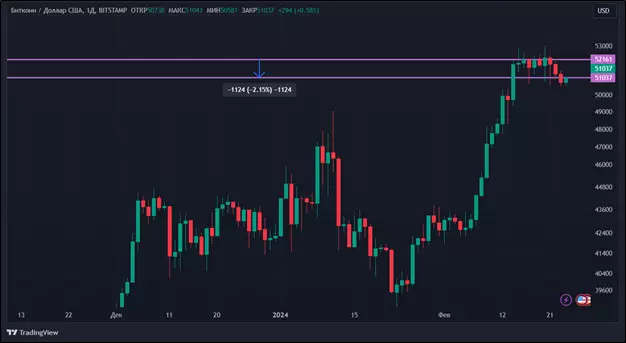
Source: tradingview.com
While Bitcoin has declined in American currency over the past week, and is still quite far from reaching its all-time high in dollars, BTC has already reached it in other countries. Of course, for the most part these are either countries on the African continent or those where inflation is extremely high (Argentina, Turkey). The most notable in this regard is one of the strongest economies in the world – Japan. Such information on social network X shared user under the pseudonym Balaji.
Another interesting news of the past week was report European Central Bank (ECB). In it, the regulator once again expressed skepticism regarding Bitcoin. The ECB called the fundamentals of the first cryptocurrency nothing less than “fantastic conditions for a snake oil salesman.” The report itself is titled “Bitcoin ETF Approval—The Naked King’s New Clothes.” According to the ECB, Bitcoin remains inconvenient, slow and expensive. And of course, mining pollutes the environment. The report also notes that the latest increase in the value of BTC is speculative, and the cryptocurrency is often used in criminal schemes.
Naturally, crypto enthusiasts were not satisfied with this point of view. Most of them began to mock the ECB's report in X. For example, a user with the pseudonym Hsaka posted the previous ECB statement regarding Bitcoin. Since then BTC increased more than three times. And Ryan Selkis is just stated: “The euro will be dead in 4-5 years. Bitcoin will be alive and thriving as long as the nodes that support the core Bitcoin client exist.”
Despite the decline in recent days, BTC continues to remain in bullish territory. The price is above the 50-day moving average (in blue) and the RSI indicator is above 50. The nearest resistance level is $53,015, and the nearest support level is $50,519.
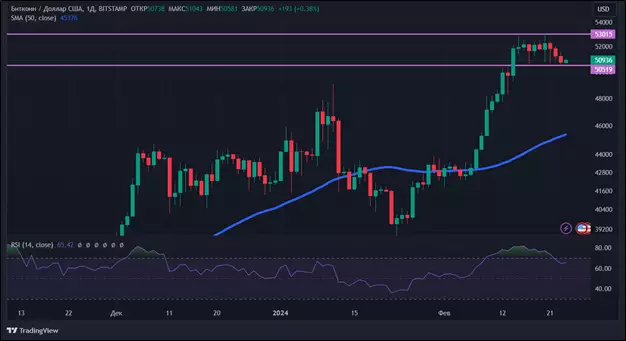
Source: tradingview.com
Fear and Greed Index compared to February 16 remained unchanged – it is 72. This indicates that greed still reigns in Bitcoin.
Ethereum
The price of ether rose by 5.25% from February 16 to February 24. Moreover, on February 20, it reached $3,000, which has not happened since May 2022. However, later the price of the second largest cryptocurrency by capitalization adjusted slightly and now it is about $2,950.
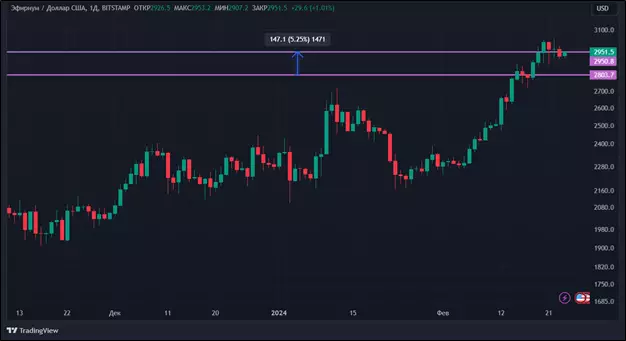
Source: tradingview.com
The primary reason for this movement in the airwaves continues to be demand from large players (whales). So, on February 22, one of them bought 16,160 ETH worth just under $47 million. In total, within four days, he purchased 87,819 ETH worth $252.5 million. The total amount of ether in the possession of this investor amounts to 112,996 ETH.
The situation around spot Ether ETFs also continues to evolve. A week ago it became known that Franklin Templeton Investments had submitted an application for such a product. And on February 23, the Chicago Board Options Exchange (CBOE) filed Form 19b-4 in support of it. Thus, the site gave the US Securities and Exchange Commission (SEC) a detailed opinion on the Franklin Templeton Investments ETF and the impact it will have on the market. Such actions indicate that the approval of exchange-traded funds for ETH becomes more and more real.
From a technical analysis point of view, there is a dominance of bulls in Ether. The price is above both the 50-day (in blue) and 200-day (in orange) moving averages. Thus, the cryptocurrency looks strong both in the medium and long term. Further growth can be expected after breaking through the resistance level of $3,036.4, the high of last week. Support level is $2,870.
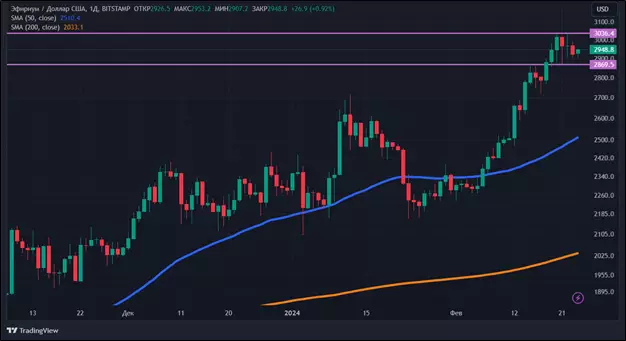
Source: tradingview.com
Avalanche
From February 16 to February 24, Avalanche dropped 10.69% in price. Negative dynamics were observed throughout this period; only two sessions out of eight were in the black. The price could not stay above $40, and at the minimum it came close to $35.
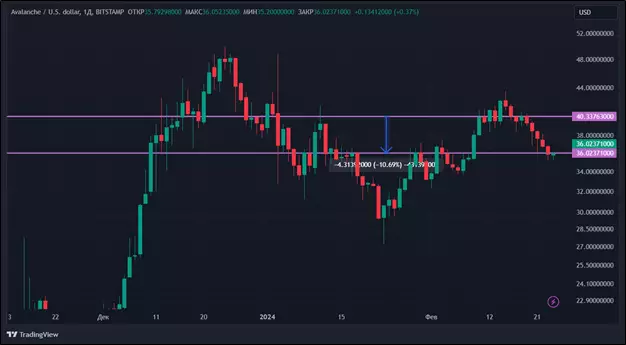
Source: tradingview.com
The Avalanche's downtrend was defined by two pieces of news. The first of these was the next unlocking of AVAX tokens on February 22. On this day, the supply immediately increased by 9.54 million. This caused a natural, from an economic point of view, decline. After all, as you know, an increase in supply with insufficient demand causes a decrease in value. The next such event is scheduled for May 22, when the next 9.54 million tokens will be unlocked.

Source: token.unlocks.app/avalanche-2
If the first news was rather neutral economic in nature, the second turned out to be clearly negative. On Friday, February 23, Avalanche experienced an outage that halted block production. Initially, a problem with a new wave of “inscriptions” was cited as the reason for the suspension of work. At that time, she only worked for one hour. About it stated co-founder of Avalanche's parent company, Ava Labs, is Kevin Sekniqi.
However, it later turned out that this was not the reason. An error was reported in the code related to mempool management. Problem with captions took placebut did not affect network performance.
According to technical analysis, it is time for the bears in Avalanche. The price has dropped below the 50-day moving average (in blue). The RSI indicator has dropped below 50. The support level is the minimum of February 23 and 24 – $35.2, the nearest resistance level is $37.6.
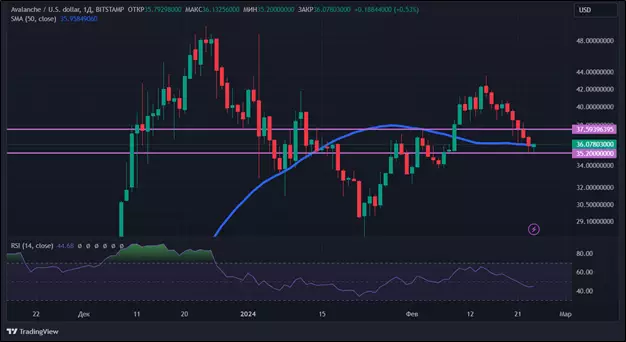
Source: tradingview.com
Conclusion
Thus, over the past week, the dynamics of cryptocurrencies have been unclear. Bitcoin showed a weak correction, Avalanche collapsed due to a network failure, and Ethereum continued to grow due to the demand of large players and positive expectations from the approval of spot ETH ETFs.
This material and the information contained herein do not constitute individual or other investment advice. The editors' opinions may not coincide with the opinions of the author, analytical portals and experts.
Source: Bits
I am an experienced journalist, writer, and editor with a passion for finance and business news. I have been working in the journalism field for over 6 years, covering a variety of topics from finance to technology. As an author at World Stock Market, I specialize in finance business-related topics.







